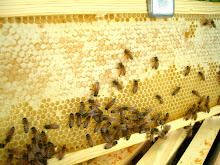This morning it was time to do another hive inspection. In my monthly email from Brushy Mountain, a new beekeeper blogs about her first-year experiences. She shared that she'd made the mistake of not inspecting the bottom super of her hive, assuming that if all looked well in the top supers, the bottom would be okay, too. Well, apparently all was not quite well. So I took her warning to heart and inspected my hives, top to bottom, today.
Rocky was first. Taking off the top super and setting it aside, I pulled some frames from the bottom super. What I saw scared me a bit — there was lots of sugar water being stored and capped, but I didn't see any capped brood, larvae or pupae. I put the second super back on top and pulled frames from it. There were the missing brood, larvae and pupae! When the swarm bees were in their temporary hive, I'd used a super with frames on top of the cardboard box. When I assembled the permanent hive, I made a mistake — this super, which obviously contains the queen, should have been on the bottom. I'll reverse the supers sometime over the next few days and hope that it corrects the "laying" problem.
Hive A (sorry folks, still haven't made a final decision on the name) presented an unpleasant surprise. When I removed the inner cover, I was dismayed to see a bunch of small hive beetles go running for cover. There are minimally invasive beetle traps available for this. Fill one halfway with vegetable or mineral oil and insert between two frames — the beetles are attracted to the trap and will fall into the oil. Simply clean out the trap periodically and replace it. I'll have to order these traps right away. There is very little activity in the top super other than a small amount of pollen storage so it's doubtful there will be any honey this year. The middle and bottom supers are being used for brood storage and food supply. Not much capped brood, but I did see some, plus some larvae. I'm going to hope for the best.
It's inevitable that every beekeeper will face some kind of infestation problem. Small hive beetles, mites (varroa and tracheal) and wax moths are the everyday evils that my hives will have to battle. There are a few worrisome diseases out there, too, but I'm hoping they're pretty rare for a back yard beekeepeer. I'm debating about whether to medicate my bees for mites or to try to find a more "organic" prevention method. As always, the experts are all over the map in their opinions on how to treat mites, so I'll probably end up flipping a coin.
Heads or tails?
Subscribe to:
Post Comments (Atom)

I had no idea it could get so complicated and that the beekeeper has so many responsibilities. How do they survive in nature or is there any real "nature" left for them survive in these days?
ReplyDelete